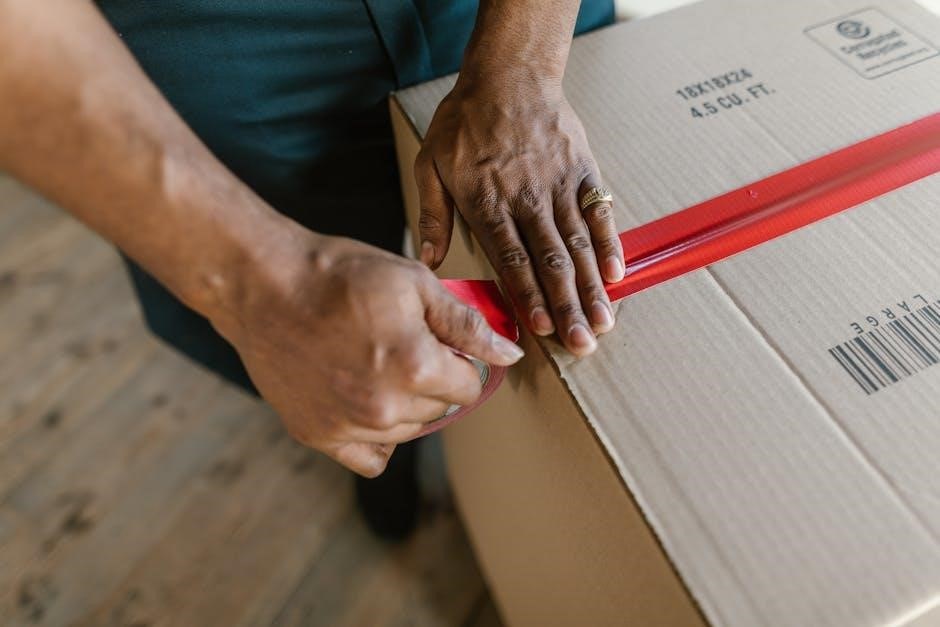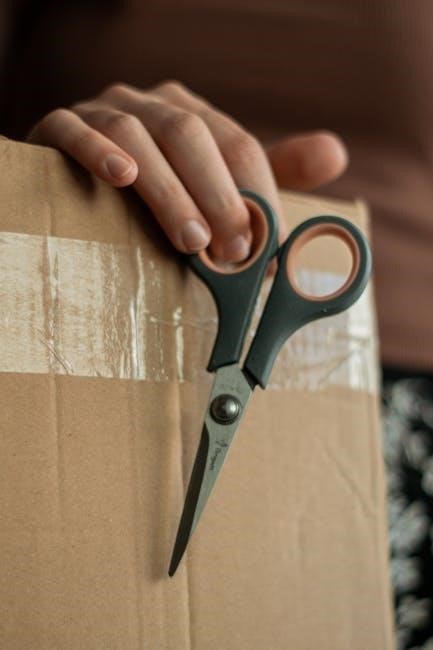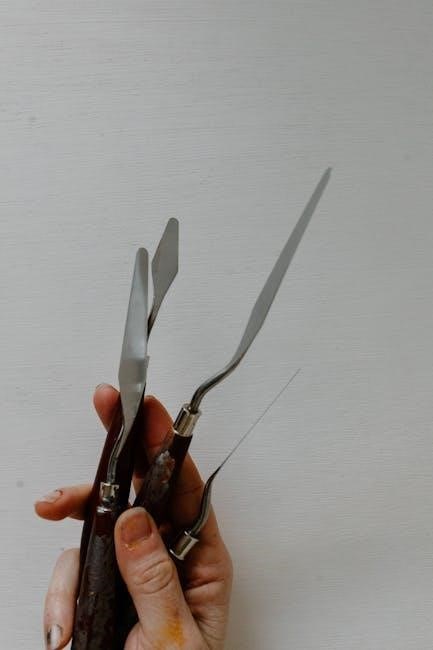A manual handling toolbox talk is a brief, interactive session that educates employees on safe lifting and handling practices to prevent injuries․
1․1 What is a Manual Handling Toolbox Talk?

A manual handling toolbox talk is a short, interactive training session designed to educate employees on safe manual handling practices․ It focuses on lifting, carrying, and handling tasks to prevent injuries․ These talks are concise, typically lasting 5-10 minutes, and are tailored to the specific workplace environment․ They often include discussions on proper techniques, hazard identification, and the use of equipment․ The goal is to engage employees, promote safety awareness, and reduce the risk of manual handling-related injuries․ Regular toolbox talks help foster a culture of safety and ensure compliance with workplace safety standards․ They are essential for industries involving physical labor․

1․2 Importance of Manual Handling Safety in the Workplace
Manual handling safety is crucial for preventing injuries and ensuring a healthy work environment․ According to the National Safety Council, one in three workplace injuries involves manual handling tasks․ Injuries from lifting, carrying, or handling objects can lead to absenteeism, medical costs, and reduced productivity․ Employers have a legal duty of care to protect workers from such risks․ Prioritizing manual handling safety fosters a culture of awareness and responsibility, reducing the likelihood of accidents․ Effective safety practices also boost employee morale and contribute to overall business efficiency․ Addressing manual handling hazards is essential for compliance with safety regulations and promoting workplace well-being․

Key Considerations for Manual Handling
Key considerations include assessing loads, maintaining proper posture, using mechanical aids, and ensuring teamwork to reduce injury risks during manual handling tasks․
2․1 Assessing the Risks of Manual Handling
Assessing the risks of manual handling involves evaluating the task, load, and environment․ Identify factors like load weight, size, and stability, as well as the worker’s capability and workspace layout․ Use risk assessment tools to determine potential hazards, such as awkward postures or excessive distances․ Consider the frequency and duration of tasks, as repetitive movements can increase injury risks․ Prioritize tasks that cannot be avoided and implement controls to minimize hazards, ensuring a safer working environment for all employees․ This step is crucial for preventing injuries and promoting a safe workplace culture․
2․2 Understanding Manual Handling Hazards
Manual handling hazards refer to factors that increase the risk of injury during tasks involving lifting, carrying, pushing, or pulling․ Common hazards include heavy or unstable loads, insufficient staff to share the workload, and poor workplace layouts that force awkward postures․ Repetitive tasks, lack of proper training, and inadequate equipment also contribute to risks․ These hazards can lead to musculoskeletal injuries, strains, and long-term health issues․ Recognizing these hazards is essential for implementing effective safety measures and ensuring a safer working environment․ Awareness and proactive steps can significantly reduce the likelihood of manual handling-related incidents․

Planning a Manual Handling Toolbox Talk
Planning a manual handling toolbox talk involves identifying the audience, preparing materials, and selecting a suitable environment to ensure effective engagement and knowledge retention among participants․
3․1 Identifying the Audience and Environment
Identifying the audience involves understanding the roles and responsibilities of participants to tailor the talk to their specific manual handling needs․ The environment should be quiet, free from distractions, and equipped with necessary tools like whiteboards or projectors․ Ensuring the space is accessible and comfortable for all participants is crucial for effective engagement․ Preparing the right materials and visual aids in advance helps maintain focus and ensures the session is informative and practical․ This setup fosters an interactive and safe learning atmosphere․
3․2 Preparing Essential Materials and Visual Aids
Preparing essential materials and visual aids is crucial for an effective manual handling toolbox talk․ Use diagrams, videos, and step-by-step guides to demonstrate safe techniques․ Include checklists for risk assessments and real-life examples of hazards; Visual aids like posture charts and lifting demonstrations help employees understand proper methods․ Ensure materials are clear, concise, and relevant to the audience’s roles․ A structured approach ensures the session is engaging and practical, fostering better retention of safety practices․

Conducting the Toolbox Talk
Start with a safety moment, engage employees through discussion, and demonstrate techniques․ Keep it concise, focusing on key points to ensure understanding and practical application․
4․1 Best Practices for Engaging Employees
Engage employees by encouraging active participation and open discussion․ Use real-life examples and interactive visuals to illustrate key points․ Encourage questions and feedback to foster a collaborative environment․ Recognize employees who contribute positively to the conversation, creating a culture of safety and shared responsibility․ Keep the session concise and focused, ensuring employees remain attentive and informed․ Provide opportunities for hands-on practice of techniques discussed during the talk․ Use clear, simple language to ensure all participants understand the material․ Follow up with additional resources or support for employees who need further guidance․

4․2 Demonstrating Safe Manual Handling Techniques
Demonstrate safe manual handling techniques through live examples and step-by-step instructions․ Emphasize proper posture, bending at the knees, and lifting with leg strength rather than the back․ Show how to hold objects close to the body and avoid twisting․ Highlight the importance of planning the lift, assessing the load’s weight, and using mechanical aids when possible․ Use visual aids like diagrams or videos to reinforce techniques․ Encourage employees to practice the methods during the session and provide feedback to ensure proper execution․ Creating a hands-on learning environment helps reinforce safe practices and reduces injury risks․

Common Manual Handling Hazards and Solutions

Identify hazards like heavy loads, poor posture, and awkward lifting․ Solutions include using mechanical aids, team lifting, and proper training to minimize injury risks effectively․
5․1 Preventing Injuries from Lifting, Carrying, and Lowering
Preventing injuries from lifting, carrying, and lowering requires proper techniques and planning․ Always assess the load for weight, size, and stability before lifting․ Keep the load close to your body and avoid twisting or jerking movements․ Use leg muscles instead of back strength to lift, and ensure clear pathways for carrying․ If the load is too heavy, consider team lifting or using mechanical aids․ Regular training on safe practices and equipment can significantly reduce the risk of manual handling injuries in the workplace․
5․2 Addressing Poor Posture and Work Practices
Poor posture and improper work practices are major contributors to manual handling injuries․ Employees often adopt awkward positions or slouch while lifting, leading to muscle strain and injury risks․ Encourage regular breaks to stretch and adjust posture․ Ergonomic workstation setups and proper training on body alignment can mitigate these issues․ Remind workers to keep objects close to their bodies and avoid twisting․ Promoting awareness of correct postures during tasks and fostering a culture of continuous improvement can significantly reduce the likelihood of injuries caused by poor work practices and posture․
A well-structured manual handling toolbox talk ensures employees understand safe practices and their importance․ Follow-up sessions and feedback loops reinforce learning and promote a safer workplace culture․

6․1 Reinforcing Learning and Promoting Ongoing Safety
Reinforcing learning and promoting ongoing safety is crucial for sustaining manual handling best practices․ Regular follow-up sessions and reminders ensure employees retain knowledge and stay vigilant․ Visual aids, such as posters and checklists, can serve as constant reminders of proper techniques․ Encouraging employees to share their experiences and near-miss incidents fosters a culture of continuous improvement․ Supervisors should consistently model safe practices and provide constructive feedback․ By integrating safety into daily routines, organizations can reduce injuries and maintain a proactive approach to workplace safety․
6․2 Encouraging Employee Feedback and Reporting Hazards
Encouraging employee feedback and reporting hazards is vital for maintaining a safe workplace․ Creating an open environment where workers feel comfortable sharing concerns ensures risks are identified early․ Supervisors should actively listen to feedback and provide resources to address issues․ Regularly discussing near-miss incidents and hazards during toolbox talks fosters accountability and continuous improvement․ Employees should be empowered to report unsafe conditions without fear of retaliation․ This proactive approach not only enhances safety but also strengthens the overall safety culture, leading to fewer injuries and a more engaged workforce․
